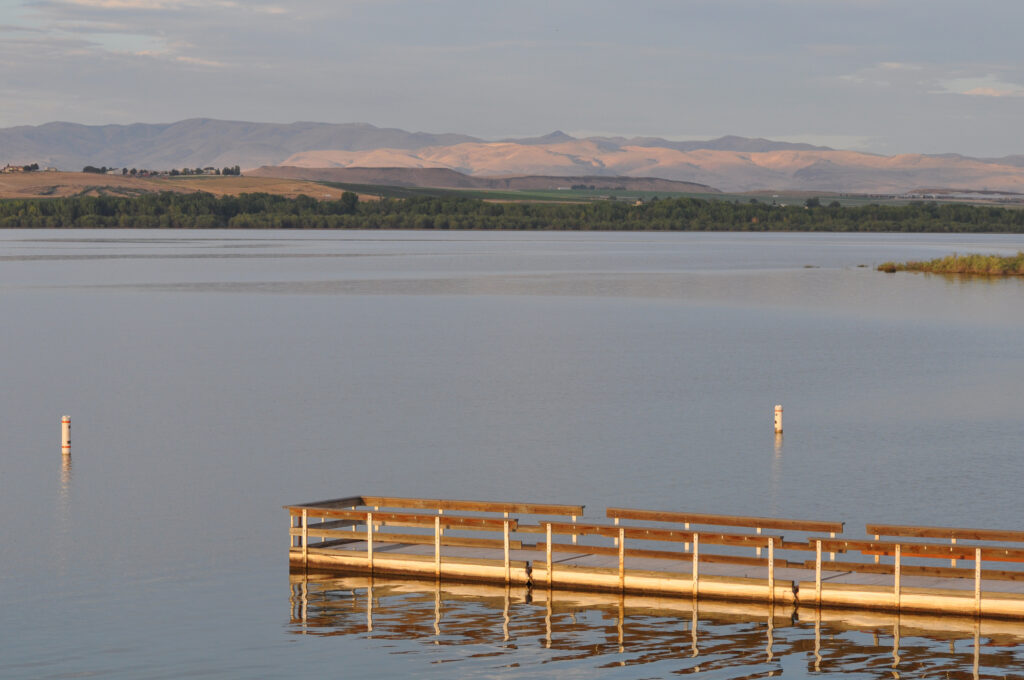Canyon County’s Lake Lowell dock at sunrise. (Getty Images)
Idahoans should use caution when recreating in or near Canyon County’s Lake Lowell due to the presence of harmful algal blooms.
Recent samples from Lake Lowell, which is about 5 miles south of the Nampa/Caldwell area in the Deer Flat National Wildlife Refuge, showed high amounts of toxin-producing cyanobacteria. The toxins they produce, called cyanotoxins, can be harmful to people, pets and livestock, according to an Idaho Department of Health and Welfare press release.
The advisory is in addition to several others across Idaho, including recent health advisories related to cyanobacterial blooms issued for the American Falls Reservoir, Avondale Lake, the Brownlee Reservoir and Cedar Creek.
Late summer and fall is the season when water bodies are most likely to have cyanobacteria harmful algal blooms, and the hazard does not immediately dissipate with cooler weather, according to Health and Welfare.
“Please exercise caution around all water bodies, as there may be affected waters that have not been tested,” the press release urged.
When recreating near Lake Lowell or other water bodies with advisories:
Avoid swimming, wading or other contact with the water. Take extra care to ensure children do not drink or get the water on them.
Ensure pets and livestock do not drink or go into the water. If they have contact with the water, clean skin, hide or fur with clean water right away.
Do not drink or cook with the water. Boiling or filtering the water does not remove the toxins and can increase the risk of becoming sick.
Wash hands thoroughly in clean water after handling fish or objects from the water.
If you choose to eat fish from the water, clean and wash fish thoroughly in uncontaminated water. Fillet the fish, and remove all fat, skin, and internal organs before cooking. Cyanotoxins can build up in fish, and the risk to people is unknown.
Watch for symptoms. If you touch or swim in the water or breathe in water droplets, you might experience a rash, hives, red eyes, wheezing, coughing or shortness of breath. If you swallow the water, you might have stomach pain, diarrhea or vomiting. You might have a headache, muscle weakness or dizziness. If your liver is damaged, your skin might turn yellow, and you will have dark urine. If you think you might be sick from cyanotoxin, consult your health care provider or call the poison center at 1- 800-222-1222. Notify algae@deq.idaho.gov.
Monitor media reports and DHW’s website for health advisories.
“Cyanobacteria are a natural part of Idaho’s water bodies. When temperatures rise, their populations can bloom and toxic chemical compounds, or cyanotoxins, can be released into the water,” the press release states. “Blooms don’t all look the same. They may look like mats, foam, spilled paint, or surface scum, and have a foul odor.”
Mats can be out of sight on the bottom of the water body. Pets, livestock and wildlife can get sick or die within minutes to days after cyanotoxin exposure, according to Health and Welfare.
For more information about cyanobacteria harmful algal blooms, visit DEQ’s website at www.deq.idaho.gov/water–quality/surface–water/cyanobacteria–harmful–algal– blooms/ or DHW’s website at www.gethealthy.dhw.idaho.gov/recreational-water-health-advisories. The public will be notified once the advisory is lifted, Health and Welfare said in its press release.
YOU MAKE OUR WORK POSSIBLE.

